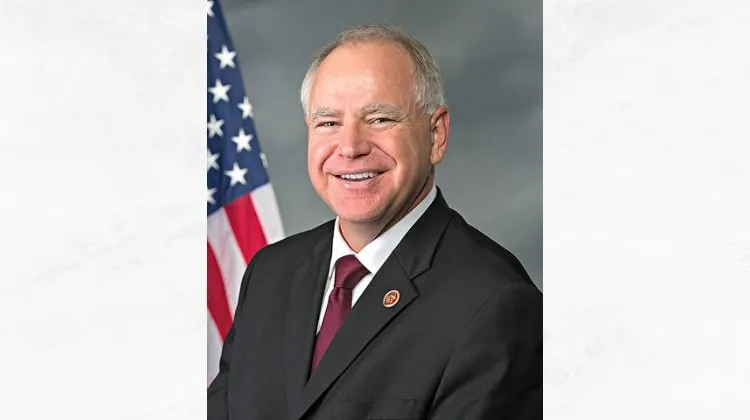When politicians campaign for office, their backgrounds and experiences often take center stage. This is particularly true for those who’ve served in the military, as their service record becomes a focal point for both supporters and detractors. Tim Walz, the current governor of Minnesota and a potential running mate for Vice President Kamala Harris, is no stranger to this scrutiny. Tim Walz’s military record has been both praised and criticized, prompting a closer examination of his two-plus decades in the Army National Guard.
Tim Walz’ military record spans 24 years, beginning with his enlistment in the Nebraska Army National Guard in 1981 at the age of 17. This decision set him on a path that would intertwine military service with his civilian life, culminating in his rise to the national political stage. However, this journey has not been without its controversies, with questions surrounding the timing of his retirement, when he would have been a prime candidate to be a command sergeant major, in relation to a deployment to Iraq.
Table of Contents:
- Early Career and the Path to Leadership
- Operation Enduring Freedom: Deployment to Italy
- Retirement and the Iraq Deployment Controversy
- The “Stolen Valor” Accusation
- Congressional Career and Advocacy for Veterans
- Conclusion
- FAQs about Tim Walz’s military record
Early Career and the Path to Leadership
Walz’s military career began in the thick of the Cold War. He enlisted as an infantryman in the Nebraska Army National Guard. His dedication and skill were evident early on, leading him to later transition to field artillery.
In 1996, after years of service marked by responses to domestic events like floods and tornadoes, Walz transferred to the Minnesota Army National Guard. This move coincided with his growing family life with his wife, Gwen, as they settled in southern Minnesota.
Balancing Service with Civilian Life: A Common Thread for Guardsmen
It’s crucial to understand the unique demands placed upon members of the National Guard. Unlike their active-duty counterparts, these citizen-soldiers balance military service with civilian careers and family responsibilities. They are soldiers, teachers, police officers—everyday citizens who answer the call to serve, often with little notice.
This balancing act is a constant reality for Guardsmen, requiring them to make tough choices and sacrifices. Many wonder if Walz considered a presidential campaign during his time in the Guard.
Operation Enduring Freedom: Deployment to Italy
In 2003, following the events of 9/11, Walz reenlisted rather than retire. This demonstrated his commitment to serving his country in a time of heightened global tension.
That same year, he deployed to Italy as part of Operation Enduring Freedom. While stationed at Aviano Air Base in Italy, his unit was tasked with providing security.
Importantly, Walz did not see combat during his time in Italy, and this detail has fueled debate regarding the characterization of his service. Some have drawn comparisons between his time in service and that of potential Republican vice presidential nominee J.D. Vance, who served in the Marine Corps.
Retirement and the Iraq Deployment Controversy
Walz retired from the Minnesota National Guard in May 2005 as a command sergeant. Two months later, his former unit received an alert order for mobilization to Iraq, eventually deploying in March 2006.
This timeline has been a source of contention. Some critics, including Republican figures like Senator J.D. Vance, argue that Walz retired to avoid deploying to a combat zone.
Fact-checkers have pointed out that this claim lacks evidence and that Walz had signaled his intent to retire and pursue a political career, possibly even as a vice presidential nominee, prior to his unit’s official deployment notice. Despite these rebuttals, the perception of his retirement coinciding with an imminent deployment has lingered.
A Deeper Dive into Guard Deployments: Separating Fact from Fiction
The National Guard deployment process can be complex and subject to change. Units may receive preliminary warnings or alerts about potential deployments years in advance. This was the case with Walz’s former unit, which received notification about a possible mobilization to Iraq in March 2005, two months before Walz’s retirement.
This alert mentioned a potential mobilization within two years, not an immediate order. Such advance notices are common in the Guard but don’t always translate into definite deployments. The timing can change based on operational needs and evolving situations in the theater.
To suggest Walz had definitive knowledge of a specific deployment date when he retired is misleading. Additionally, it’s essential to note that Guard deployments can be highly disruptive to civilian careers and personal lives, often necessitating difficult personal decisions.
The “Stolen Valor” Accusation
Senator Vance, himself a Marine Corps veteran, escalated the criticism of Walz’s service record by accusing him of “stolen valor.” This term refers to individuals who falsely claim military awards, decorations, or service they did not earn.
The accusation stems from a 2018 campaign video in which Walz stated that he had carried “weapons of war, that I carried in war.” Vance and other Republicans have used this clip, coupled with Walz’s retirement before his unit’s Iraq deployment, to suggest he is misrepresenting his military history. This accusation, however, overlooks significant nuances.
Serving in Support of vs. Serving in Combat
While Walz’s deployment to Italy was technically in support of Operation Enduring Freedom, his service did not involve direct combat. The language used in the 2018 campaign video, while potentially open to interpretation, reflects a broader sentiment among veterans—that carrying weapons and undergoing military training, even without experiencing combat, leaves a lasting impact.
It’s a shared experience that bonds those who’ve served, regardless of their specific deployments. Vance’s use of the term “stolen valor” in this context has drawn criticism for being overly harsh and missing crucial context.
Walz has received support from other veterans who see his decades of service and commitment to the National Guard as genuine, even if his experience doesn’t align with Vance’s definition of wartime service. Walz served as a sergeant major, a high rank that comes with significant responsibility.
Congressional Career and Advocacy for Veterans
Walz was elected to Congress in 2006 and served six terms. Notably, he became the highest-ranking enlisted soldier ever to serve in Congress. His time in Congress was marked by his work on the House Agriculture, Armed Services, and Veterans’ Affairs committees.
Walz’s legislative record reflects a commitment to veterans’ issues, pushing for better care, education benefits, and support for those returning from deployments. His advocacy work continued after he was elected governor of Minnesota in 2018, making veterans’ well-being a key priority of his governorship.
Beyond the Timeline: A Holistic View of Service
Examining Tim Walz’ military record solely through the lens of his retirement timing and his 2018 campaign statement fails to encapsulate the totality of his experience. He served for 24 years, navigating the demanding dual roles of soldier and civilian. He demonstrated his willingness to serve even after fulfilling his initial obligation.
While criticisms of his record persist, focusing narrowly on a select few moments disregards the full context and impact of his military service. Critics often compare Walz’s record to that of other politicians who have served, including potential presidential candidates and vice presidential candidates.
Conclusion
Tim Walz’ military record presents a complex portrait of a life interwoven with military service. He answered the call to serve at a young age, dedicated decades to the National Guard, and ascended to its highest enlisted ranks. His career was not one of constant deployments to war zones but of commitment to his state and country, even while balancing civilian obligations.
While the timeline surrounding his retirement and accusations of embellished service may persist in political discourse, they shouldn’t overshadow the broader narrative. A fair assessment of Tim Walz’ military record must take into account the sacrifices, dedication, and years of service he rendered.
FAQs about Tim Walz’s military record
What branch of the military did Tim Walz serve in?
Tim Walz served in the Army National Guard for 24 years.
When and why did Tim Walz retire from the National Guard?
Walz retired from the Minnesota National Guard in May 2005, citing his intention to run for Congress as the reason.
Did Tim Walz deploy overseas during his time in the military?
Yes. He deployed to Italy in 2003 in support of Operation Enduring Freedom, where he was stationed at Aviano Air Base, but did not experience direct combat.
What is the controversy surrounding Tim Walz’s retirement and his unit’s deployment to Iraq?
Walz retired from the National Guard two months before his former unit received an alert for potential mobilization to Iraq. They deployed to Iraq the following year. Critics argue this shows Walz retired to avoid combat, a claim disputed by fact-checkers and his supporters, who cite his prior intentions to run for political office.




Tim Walz is a liar and a POS!
I am a Vietnam and Thailand Veteran with 492 days in Indo-China War zone. I want to thank Governor
Tim Walz for his Service to his Country. At lease he didn’t Lie and say he had Bone-Spurs to get
out of Servicing his Country, Like the Coward 45th President of the United States. neither he or
his Sons or his Father Served Our Country, They are Liars and takers only. Thank you Tim Walz
for your Service, Veterans should stand-up for other Veterans.
More lies! He is not the running mate of Joe Biden but of Kamala Harris. That is a BIG difference!
Misrepresentation of his rank, in my eyes, is stolen valor. I served in Vietnam with the 101st Airborne infantry. It does not sit well with me that he used the phrase of, “weapons of war, that I carried in war.”